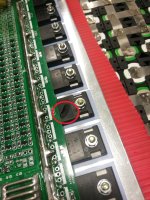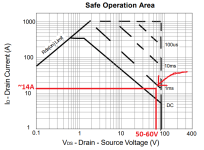EddySPalm
100 W
Hi,
I bought the only 16s BMS I could find that was supposed to handle 150A continuous, and the other day I was testing my battery pack for temperature rise, only to find out that the batteries did fine, but the BMS did not! After roughly 1/2 minute (1 minute 25seconds into the video) at 110A we heard a "pop" from the battery, which revealed itself as being one of the transistors literally blowing up/exploding :lol:
So I am trying to get a replacement from Supower/Batterysupports, but how can I be confident that a new identical BMS will behave any differently?
Now I know I've asked this before, but can someone please recommend me a good quality 16s BMS that can handle contiuous current draw close to 150A?
Now use this golden opportunity to learn some Norwegian, and watch the ever so boring video of our battery test
https://www.dropbox.com/s/nd3348g3sw4wick/2018-02-23%2020.05.21.mp4?dl=0

I bought the only 16s BMS I could find that was supposed to handle 150A continuous, and the other day I was testing my battery pack for temperature rise, only to find out that the batteries did fine, but the BMS did not! After roughly 1/2 minute (1 minute 25seconds into the video) at 110A we heard a "pop" from the battery, which revealed itself as being one of the transistors literally blowing up/exploding :lol:
So I am trying to get a replacement from Supower/Batterysupports, but how can I be confident that a new identical BMS will behave any differently?
Now I know I've asked this before, but can someone please recommend me a good quality 16s BMS that can handle contiuous current draw close to 150A?
Now use this golden opportunity to learn some Norwegian, and watch the ever so boring video of our battery test
https://www.dropbox.com/s/nd3348g3sw4wick/2018-02-23%2020.05.21.mp4?dl=0



